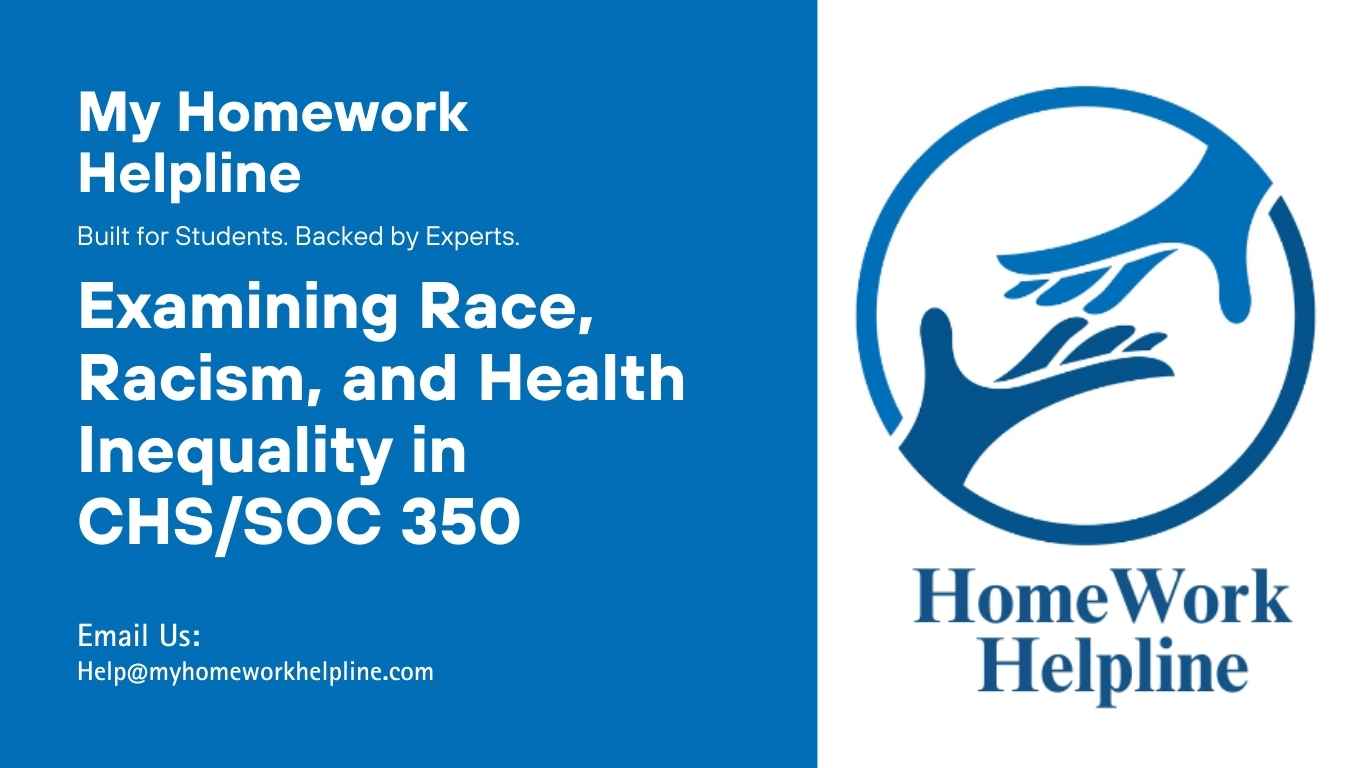Race, Racism, and Health Inequality Article Summary: Key Concepts and Takeaways from CHS/SOC 350
Part 1: Concepts
Sample:
| Embeddedness | A concept from economic sociology is that markets and the economy are always part of (or “embedded”) in society. (Gravette 1985) |
| Concept | Definition |
| Race | A concept from race, racism and health outcomes depicting that race is a dynamic social construct that widely offers more possibilities regarding skin colour and phenotype (University of Cambridge, 2016). |
| Ethnicity | A concept from the social construct depicts the state of emerging from a particular social group exhibiting similar cultural traditions within the environment (Bhala et al., 2020). |
| Fundamental Cause of Health | It is a concept from the fundamental cause theory that depicts the attempt to initiate a solution to the underlying puzzle of existing social inequalities in the healthcare system (University of Cambridge, 2016). |
| Expendability | A concept from the healthcare outcomes depicts that the elements of social inequality can be eliminated by increasing the incorporation element of people towards services. |
Need help analyzing complex sociological concepts or completing assignments on race, inequality, and health outcomes? Our academic experts provide customized support for essays, article reviews, and research projects in courses like CHS/SOC 350. With step-by-step guidance, you can strengthen your arguments and improve academic results. Visit our environmental science homework assistance today to access professional help that ensures your papers are clear, well-structured, and impactful.
Part II: Take-Aways
| (University of Cambridge, 2016)
Race, racism, and health outcomes. |
Race emerges as a biological concept and later transforms into a social construct weaponized against most of the minority individuals within the society. The social construct has established the relationship between race and people’s health. In most cases, it results in elements of inequality within the environment. The social construction of race marks from the 20th century transformed the thought around race and racism. The racial groups have been established through racialization and existing differences. Interracial people are influencing the view on racism and eliminating boundaries. African Americans are the most disadvantaged group within a society dominated by whites. It stretches to health discrimination and inequality. The racialized social system and health disclimaxes the minority blacks against certain healthcare services within the environment. |
| – I like the author’s logic on page 9 regarding the penalization of overt racism and its outcomes. The author pinpoints the need the strive for racial equality among all the people within the environment, regardless of skin colour. It is one of the significant advances toward developing a sense of equality within the environment.
– It is also worth noting that the increased incidences and stereotypes of racism have subjected blacks to inadequate access to medical care and treatment within the healthcare facilities resulting in poor health outcomes within the medical facilities. – The racial stereotypes of the minority blacks on the aspect of crime have led to increased police cases and a higher number of African Americans in correctional facilities than any other race within the nation. |
|
| Targeting minorities, low-
income neighbourhoods for hazardous waste sites. University of Michigan: Michigan News. |
Industries disproportionately locate polluted and dangerous waste sites in minority and low-income areas (which we know leads to the declining health of low-income communities). This study by researchers at the University of Michigan analyzed data from other academic studies to identify “apparent trends of socioeconomic and racial inequalities in the distribution of a vast range of environmental risks. The stipulated section of the population is known to exhibit minimal resistance legally due to inadequate resources and capital. The practice adopted by these companies will result in detrimental health complications for the stipulated population due to the inability to afford high-quality water and access quality care in hospitals. |
| – The author’s flaw in reasoning, addressed by me on page 3, bothered me. It’s doubtful that dangerous facilities would entice a population shift and instead have to rely on coercion to achieve their goals. Property values in the area would plummet due to these developments, making them ideal locations for affordable housing.
– With the addition of the word “political clout,” the author’s interpretation of “the route of least resistance” rings more accurate. It was a well-thought-out defence against the accusation that the low-income population acquiesced because they took the path of least resistance. |
|
| – I like how the author points out that the medical knowledge about women was presented based on sexist and essential theories that could ignore the link to bare life. The feminist criticism of the healthcare system differed from social class inequality.
– There is a crucial link and influence of social class and medical quality among the people within the community. |
|
References
Bhala, N., Curry, G., Martineau, A. R., Agyemang, C., & Bhopal, R. (2020). Sharpening the global focus on ethnicity and race in the time of COVID-19. The Lancet, 395(10238), 1673-1676. https://www.ncbi.nlm.nih.gov/pmc/articles/PMC7211499/
Targeting minority, low-income neighbourhoods for hazardous waste sites. University of Michigan: Michigan News. Retrieved from: https://news.umich.edu/targeting- minority-low-income-neighbourhoods-for-hazardous-waste-sites/
Theorizing Social Inequalities in Health. (2016). Inequality and African-American Health, 11–14. https://doi.org/10.46692/9781447322832.003
University, C. (2016). Race, racism, and health outcomes. Inequality and African-American Health, 15–28. https://doi.org/10.46692/9781447322832.004

